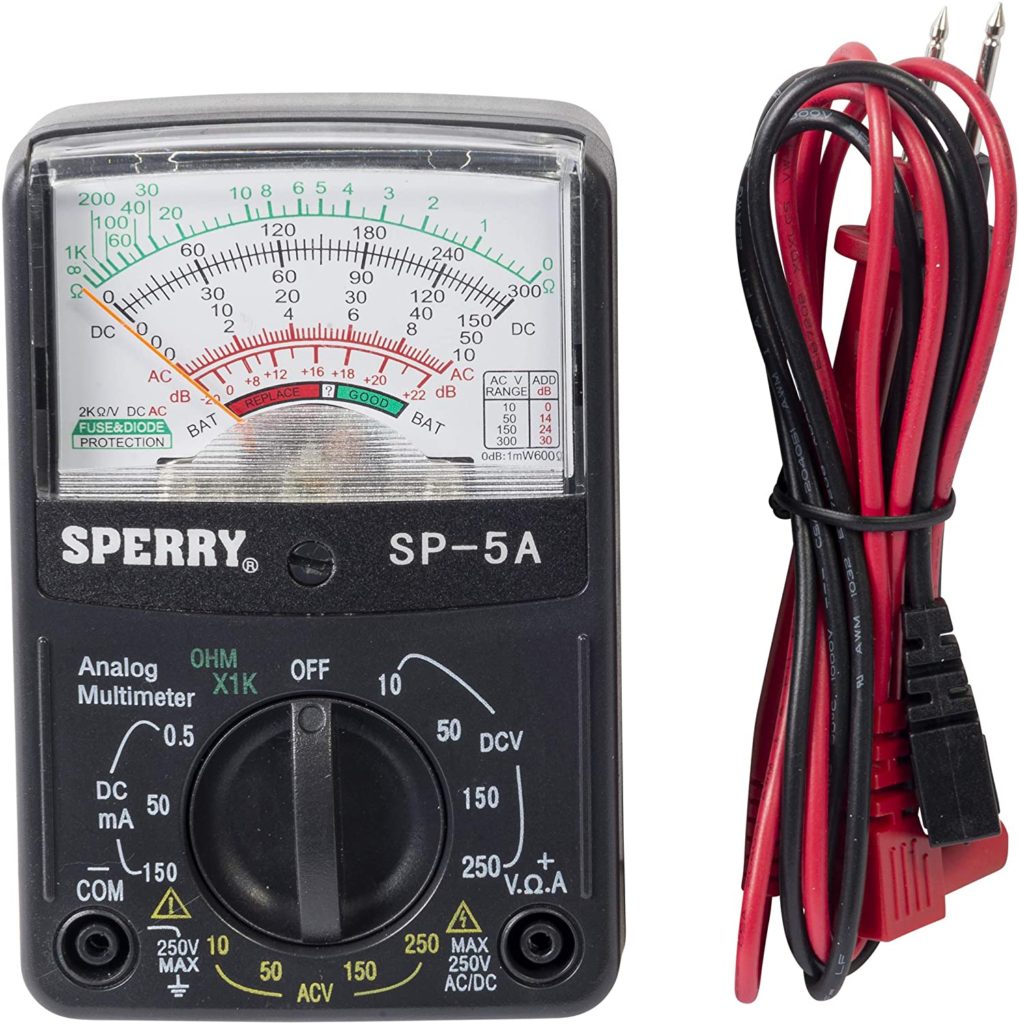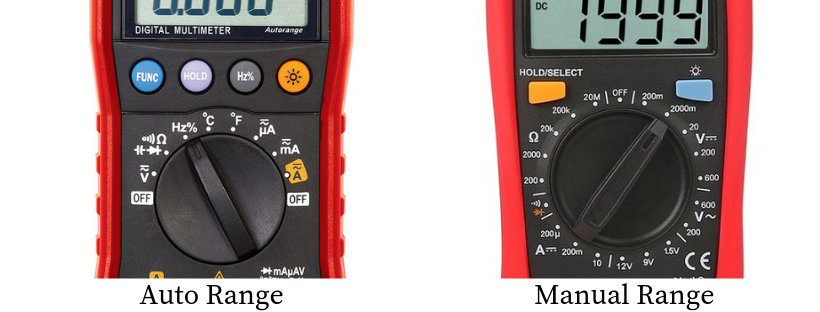Hi! Hope you are having a good life. In this post, I am going to share what I have learned so far when buying a decent multimeter. In more appropriate words this post is like my own multimeter buying guide.
I was not that smart at the very beginning, I bought my first multimeter just considering it should measure voltages and resistances.
That was all my buying preferences. But with time as I continued to learn electronics and practice projects, I learned what should I look for in a multimeter as different projects demanded different types of measurements.
Hopefully, you will find these tips useful for buying your own multimeter.
Multimeter Buying Guide
You know, buying a multimeter might sometime get very tricky. A buyer gets no clear idea of what he should look for in a decent multimeter. I was myself in that position too.
Following are the tips, you should consider when going for your multimeter.
1. Digital vs analog multimeter
There exist two types of electronics products – one is the old technology called the analog and the second is the latest one called the digital. And luckily we are belonging to the latter one, which is very cool.
I love this digital world and the same goes for selecting a multimeter. There exist people who appreciate analog multimeter saying it is more accurate, but for me, analog is no more a choice.

There are a few reasons why I don’t like analog multimeters.
- You cannot see your measuring parameters directly on an analog multimeter screen, it has just a needle that points to a value that you have to manually read by yourself.
- God knows if your eyes vibrate like me then there is no chance for you to accurately measure the readings.
- Further, the written values on it are so messy and condensed, that you need a training tutorial on how to read the values of your interest.
- I appreciate the analog meter for measuring signal strength in dB. But who cares for this when we know a multimeter is not a very specific device for it. I can say it is an extra feature.
2. Auto range vs manual range
If you are a beginner or don’t have money then you can buy a manual range meter. Else, just don’t think of it. It is a waste of time and very tedious to work with.
Auto range meter selects its range itself. You just need to connect the device, select the parameter on the meter which you want to measure, and read the value on its screen. Done! It can’t be more simple than this. All the rest of the work will be done for you.
While in the case of a manual meter. It is very tedious and very annoying when you have to deal with many values and components for a project. You have to yourself select the range by turning the nob all the time.
3. Safety features (CAT safety measures)
Safety is my first priority when dealing with any electronics tool. If you are a beginner and just want to measure resistance values and play around with small 5V DC voltages, I can say go for any cheap meter.
But looking for a professional meter, where you are going to measure high current and AC or DC voltages, safety can’t be replaceable at any cost. And please don’t play with your life, get yourself a high-quality meter from a trusted manufacturer.
Besides the above, the following are the must features.
- The first thing you need to do is to check for all the fuses a meter uses. If it is using a glass fuse, and you want to measure high current or low currents, don’t waste your money on it. Multimeter measuring currents must have high-quality cartridge fuses to make them safe. If your multimeter doesn’t have these fuses it is not safe, it can burst and can catch fire if you make a mistake.
- The second thing to look for is a CAT III rating. These ratings ensure your multimeter will not blow in your hands, and you will be safe if you accidentally short the mains.
- The third thing is to have quality probes i.e., made of silicone rubbers.
4. Range limits
Ranges are of the most important things to look for. You never know what value parameters your projects may demand. Like, my first meter could not measure current in milli range. I noticed this issue when I had to measure some sensor current values.
The point I am emphasizing is, that your multimeter ranges should cover your present and future project demands.
Following are my recommended ranges;
- Current Range: 10uA to 10A
- Resistance Range: 10 Ohm to 20MOhm
- Some picofarad to a decent high range (maybe in milli range); In electronics, we usually deal with small capacitance, so my focus is on how low-value capacitance a meter can measure.
I didn’t use a multimeter for high voltage measurements, for me voltage range from a few millivolts to 600V is fair enough.
5. Input resistance
Some of you may be encountering this for the very first time. So, let’s first explain it a little. As the name suggests, the input resistance of a multimeter is the resistance it offers to the device connecting across its probes.
The higher the input resistance, the better your multimeter is. Typically, 1MOhm is considered a fair value.
6. Accuracy
When we talk about multimeter accuracy, I really don’t consider it that much important. A 0.5% DC volt accuracy with 4000 or 6000 counts is fine. Greater than this value makes your meter not professional and a waste of money.
Furthermore, a multimeter must have true RMS reading when measuring AC voltages and measuring bandwidth beyond 50kHz.
7. Diode measuring feature
You can find this feature under the diode or continuity function symbol on your multimeter. Most multimeters have this function, but the problem is, it is the test voltage range is close to 2V. A good meter should have a test voltage range of close to 4 Volts to measure almost every device.
8. Continuity response time
The quicker the response time, the better your multimeter. It is very handy when you are analyzing your circuit for short or open situations. If the response time is slow, it can be very time confusing and annoying.
9. Battery time
Battery time is very important when you are a regular user of the multimeter. 1000 hours of battery time is considered decent. Don’t waste your money buying any meter having a battery time below 1000 hrs if you are serious about learning electronics.
10. Auto hold function
This is a very handy feature to look for in a multimeter. What does this feature do? It makes measurement easy. You connect the probes using both hands and the multimeter reads the values even when you are not looking at its screen.
The reading remains on the screen even if you remove the probes. This is a very good safety measure when you are working with AC mains, where you need to be just focused on connecting the probes right and making sure not to touch any wire accidentally.
Conclusion
This is all I could share to the best of my knowledge about a multimeter buying guide. A multimeter is a very basic tool you must have in your lab if you are taking electronics seriously.
You can buy any meter without wasting a second of thinking. But by doing so you may end up in a bad quality product using which you can harm yourself. And multimeter can be very dangerous. So, in this post, I try to explain a few parameters you should pay very close attention to when you are buying a multimeter.
The following are some of my recommendations you can consider.
- Mastech MS8268 Digital AC/DC Auto/Manual Range Digital Multimeter Meter (Amazon Link)
- INNOVA 3340 Automotive Digital Multimeter (Amazon Link)
- KAIWEETS Digital Multimeter (Amazon Link)
Hopefully, this article added some value to your life and helped you in some way.
Other useful posts
- The best beginner multimeters [Branded & Affordable]
- Insanely Best Beginner Oscilloscopes [Branded & Affordable]
Thank you and have a grateful life.

